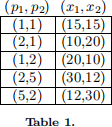关键词 > ECON6001/6701
ECON6001/6701 Microeconomic Analysis 1, S2 2022 Problem Set 4
发布时间:2023-09-04
Hello, dear friend, you can consult us at any time if you have any questions, add WeChat: daixieit
Problem Set 4
ECON6001/6701 Microeconomic Analysis 1, S2 2022
1. Take the “Duality” flow diagram given in your Lecture 4 slides. Verify the entire diagram for the CES utility function

(You may take as given that this function is strictly quasi-concave).
2. Using the expressions you obtain in the previous question, verify that the equation for the substitution term ( the sij entry in Slutsky matrix) holds. That is compute the RHS and the LHS of the following equation and verify that it is satisfied.

Is the income effect always positive?
3. Consider following five observations of price - quantity pairs

a. Explain why this data is consistent with a consumer maximizing a concave utilty function. (You might find it helpful to construct a 5![]() 5 matrix of expenditures).
5 matrix of expenditures).
b. Plot all consumption points and the budget lines on a graph paper. Using the Weak Axiom and the Generalized Axiom of Revealed Preference, indicate the shaded region through which the indifference curve passing through (15; 15) (the first consumption choice), might lie.
4. In terms of an expenditure function e(p; u), we may write (See pg 10, Lec 4 slides for example) compensating and equivalent variations as
CV = e(p0 ; u0) ¡e(p1 ; u0)
EV = e(p0 ; u1) ¡e(p1 ; u1)
where (p0 ; u0) and (p1 ; u1) are the initial and final price/utilty pairs.
For the utility functions given in Q1 above, check the relation between CV, EV and consumer surplus. (Hint: Do not use brute force. By duality, we need only compare the areas under Hicksian demand and Marshallian demand functions. Your answer to Q2 may help.)
5. Pick any x0 and set U (x0) = u0. Let B = ![]() 0g. Note that the expenditure e(p; u0) for any price p
0g. Note that the expenditure e(p; u0) for any price p ![]() 0 is
0 is
e(p; u0) = min p . y s:t: y2 B:
Assume throughout that preferences are continuous and strictly convex.
a. Explain why p . xh (p; u0) ≤ p . y for all y 2 B. (Give a simple simple graphical explanation for the 2 good case if you are unable to do the algebra.)
b. Now, use the above observation to conclude that for any p1 >>0 and p2 >>0, we must have
(p1 ¡p2) . (x1 ¡x2) ≤ 0

